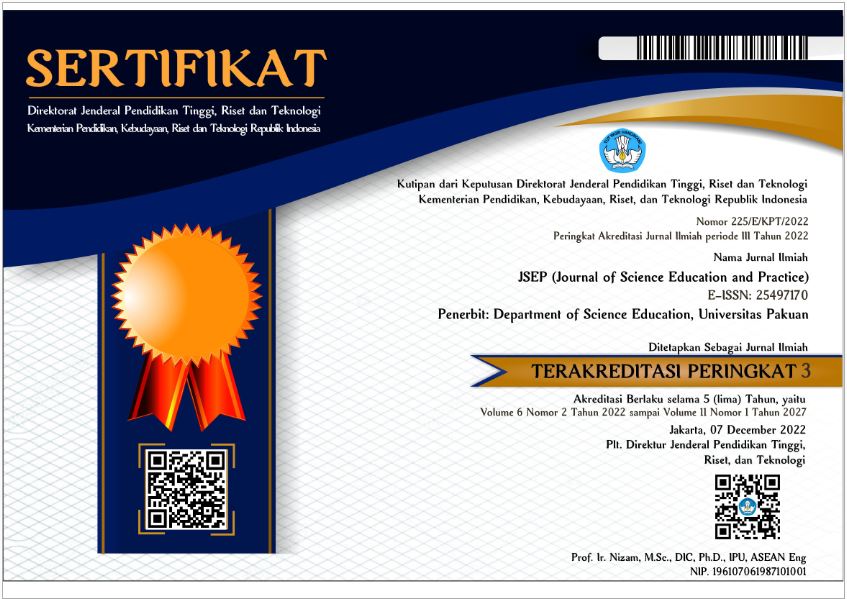ADDITIONAL MENU
DESAIN MODEL STEM-FC PADA PERKULIAHAN GEOSAINS
Abstract
Keywords
References
Afriana, J., Permanasari, A., & Fitriani, A. (2016). Project Based Learning Integrated to STEM to Enhance Elementary Schools Students Scientific Literacy. Jurnal Pendidikan IPA Indonesia, 5(2), 261267.
Bybee, R. W. (2013). The case for STEM education: Challenges and opportunity. Arlington, VI: National Science Teachers Association (NSTA) Press.
Boyle, T., Bradley, C., Chalk, P., Jones, R., & Pickard, P. (2003). Using blended learning to improve student success rates in learning to program. Journal of Educational Media, 28(23), 165178.
Capraro, R. ., & Slough, S. (2013). Why PBL? Why STEM? Why now? an Introduction to STEM Project-Based Learning. In: Capraro R.M., Capraro M.M., Morgan J.R. (eds) STEM Project-Based Learning. Rotterdam: SensePublishers.
Clark, L., Majumdar, S., Bhattacharjee, J., & Hanks, A. C. (2015). Creating an Atmosphere for STEM Literacy in the Rural South Through Student-Collected Weather Data. Journal of Geoscience Education, 115, 105115.
Dohn, N. B. (2013). Situational Interest in Engineering Design Activities. International Journal of Science Education, 12, 3741.
Firman, H. (2015). Pendidikan STEM. In Prosiding Seminar Nasional Pendidikan IPA dan PKLH, Universitas Pakkuan (pp. 19).
Garrison, D. R., & Kanuka, H. (2004). Blended learning: uncovering its transformative potential in higher education. The Internet and Higher Education, 7(2), 95105.
Geological Society of America. (2016). The Importance of Teaching Earth Science. Retrieved from http://www.geosociety.org accessed on 20-03-2019
Graham, C. R. (2006). Blended learning systems: definition, current trends and future directions. In C. J. Bonk, & C. R. Graham (Eds.). In , Handbook of blended learning: Global perspectives, local designs. San Francisco: Pfeiffer.
Han, S., Capraro, R., & Capraro, M. M. (2014). Differently : The Impact Of Student Factors. International Journal of Science and Mathematics Education
Lou, S.-J., Tsai, H.-Y., Tseng, K.-H., & Shih, R.-C. (2014). Effects of Implementing STEM-I Project-Based Learning Activities for Female High School Students. International Journal of Distance Education Technologies, 12(1), 5273
Lim, D. H., & Morris, M. L. (2009). Learner and instructional factors influencing learning outcomes within a blended learning environment. Educational Technology & Society, 12(4), 282293.
Marulcu, I. (2015). Teaching habitat and animal classification to fourth graders using an engineering-design mode. Research in Science & Technological Education. 3741.
Plomp, T. (2013). Educational Design Research: An Introduction. In T. Plomp & N. Nieveen (Eds.), Educational Design Research (p. 11). Enschede.
National Academy of Sciences. (2012). A Framework for K-12 Science Education Practices, Crosscutting Concepts, and Core Ideas Committee. Washington, DC 20055; The National Academy Press.
National Research Council. (2011). Successful K12 STEM education: Identifying effective approaches in science, technology, engineering, and mathematics. Washington, DC 20055: National Academies Press.
OToole, J. M., & Absalom, D. J. (2003). The impact of blended learning on student outcomes: is there room on the horse for two? Journal of Educational Media, 28(2-3), 179190.
Tam, M. (2000). Constructivism, instructional design, and technology: implications for transforming distance learning. Educational Technology and Society, 3(2), 5060.
Tseng, K. H., Chang, C. C., Lou, S. J., & Chen, W. P. (2013). Attitudes towards science, technology, engineering and mathematics (STEM) in a project-based learning (PjBL) environment. International Journal of Technology and Design Education, 23(1), 87102.
Voos, R. (2003). Blended learningdwhat is it and where might it take us? Sloan-C View, 2(1), 25.
Wagner, T. P., Mccormick, K., & Martinez, D. M. (2015). Fostering STEM literacy through a tabletop wind turbine environmental science laboratory activity. Journal Environmental Study of Science.
Yacobucci, M. M. (2013). Integrating Critical Thinking About Values Into an Introductory Geoscience Course. Journal of Geoscience Education, 363, 351363.
Yuen. T.T., Boekcing, M., Tiger, E.P., Gomez, A., Arreguin, A., & Stone, J. (2014). Group tasks, activities, dynamics and interaction in collaborative robotics projects with elementary and middle school children. Journal of STEM Education, 15(1), 39-45
DOI: 10.33751/jsep.v3i1.2738
 Abstract views : 548
Abstract views : 548
Refbacks
- There are currently no refbacks.
Copyright (c) 2019 JSEP (Journal of Science Education and Practice)

This work is licensed under a Creative Commons Attribution 4.0 International License.












